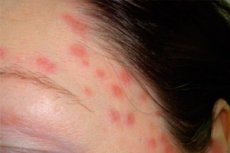Diagnosis of streptoderma
Last reviewed: 23.04.2024

All iLive content is medically reviewed or fact checked to ensure as much factual accuracy as possible.
We have strict sourcing guidelines and only link to reputable media sites, academic research institutions and, whenever possible, medically peer reviewed studies. Note that the numbers in parentheses ([1], [2], etc.) are clickable links to these studies.
If you feel that any of our content is inaccurate, out-of-date, or otherwise questionable, please select it and press Ctrl + Enter.

Streptoderma is a skin disease caused by streptococci. When infected on the body, pink spots of round shape of various diameters are formed, up to 3-4 cm. In the outbreaks of rash appears not very pronounced itching, dry crusts form, which peel off. You may experience a low temperature, an increase in lymph nodes. Their localization is more often on the face, less often on the back, limbs, buttocks. Manifestations of streptoderma are similar to many dermatological diseases, therefore, for proper treatment, it is important to carry out a thorough diagnosis.
Streptoderma Assay
In addition to the visual examination of the dermatologist and the collection of anamnesis (patient complaints, diseases, living conditions, etc.), it is necessary to make an analysis for streptoderma - to identify the pathogen by bacteriological examination. For this purpose, apply rapid methods:
- microscopic - a vesicle fluid smear is used on the virus accumulation;
- immunofluorescent - determination of virus antigens by smears;
- visurological - detection of the virus on embryonic cell cultures;
- serological - for the presence in the blood of antibodies produced under the influence of infectious agents.
As additional tests you may need blood tests:
- common;
- biochemical;
- on the Wasserman reaction (syphilis);
- thyroid hormones;
- HIV infection.
Confirmation of the diagnosis is increased ESR, C-reactive protein, leukocytosis.
In addition, they do a general analysis of urine and feces (for the detection of worms eggs).
Differential diagnostics
There are many different dermatological diseases with similar symptoms. Differential diagnosis is designed to distinguish:
- herpes from streptoderma - for both diagnoses characterized by bubbles filled with yellowish turbid liquid. Over time, they burst. Streptoderma confirms the formation of cracks in the exposed area. For herpes, it is inherent to have an itch in the place of its appearance, in the second case - redness occurs first, and only then an itch occurs;
- streptoderma from lichen shingles, pityriasis versicolor, refers to fungal infections of the skin. Infection with them does not lead to inflammation. Brownish, yellowish or pinkish spots appear on the skin surface. At first they are small, with a pinhead, then expand, forming extensive foci. The diagnosis is easily confirmed by smearing them with iodine or brilliant green, as a result of which they are painted in a brighter color;
- dermatitis from streptoderma - dermatitis is an inflammation of the skin that appears as a result of exposure to irritant. It is manifested by itching, burning, inflammation. Further, rashes, blisters, blisters, edema. Since dermatitis is most often provoked by allergens, an increase in the blood cells of eosinophils and immunoglobulins E is detected in the laboratory;
- streptoderma from chickenpox - the latter is preceded by contact with the diseased, acute onset and rapid spread of lesions to other areas, up to the mucous membranes of the mouth. Chickenpox is always accompanied by intoxication. The rash itself goes through several stages in development: a spot, a papule, a vesicle with a clear liquid, a crust. It is not peculiar to the merger of individual separate elements;
- eczema from streptoderma - eczema can develop against the background of chronic streptoderma. Typically, the flow is sluggish, slow: the skin turns red and even takes on a bluish tint, looks externally thickened, elasticity is reduced. Manifestation of dryness, itching, and severe. Healing cracks;
- pyoderma from streptoderma - staphylococcal pyoderma affects the sebaceous and sweat glands. It is localized in places of hair growth: on the head, pubis, limbs. Manifested in the form of pustules with purulent filling, after opening which forms a brown peel (with streptoderma it is yellow);
- impetigo from streptoderma - impetigo is characterized by the appearance of redness, in place of which bubbles form (flakteni), pus is collected inside them. The inflammatory process is completed by covering the lesion with a gray crust, which eventually disappears, leaving no traces. Most often, impetigo chooses the side surfaces of the body, limbs and face;
- allergies from streptoderma - manifestations of an increased reaction of the immune system to an allergen can be a burning sensation, pruritus, rash. Often other symptoms indicate the diagnosis: sneezing, lacrimation, nasal congestion, runny nose, redness of eye proteins. Confirm allergy blood test for specific IgE antibodies. To determine the allergen, you can use skin tests.


 [
[